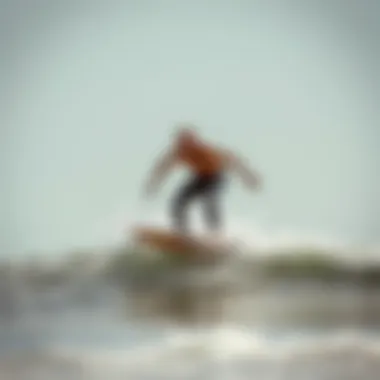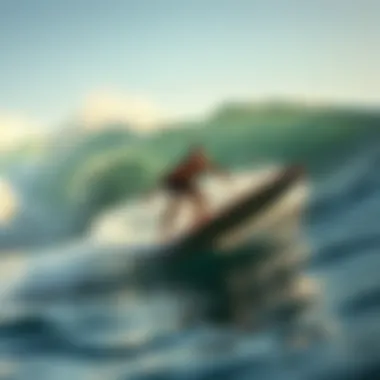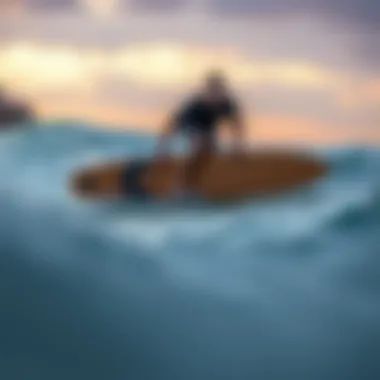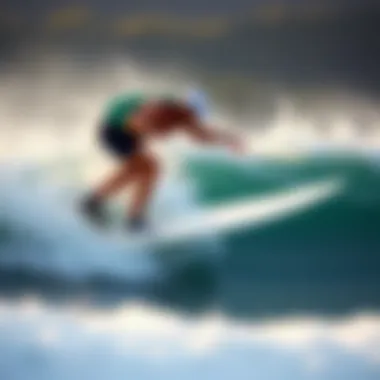Top Affordable Skimboards: A Comprehensive Review


Intro
Skimboarding, a sport that elegantly blends athleticism and artistry, has gained traction among surf lovers and sun chasers alike. It’s not just about riding the waves but a thrilling dance with the tide, where the right equipment can make all the difference. For folks looking to dive into skimboarding without breaking the bank, discovering a budget-friendly skimboard is essential. But choosing the right one often feels daunting, especially with the overwhelming choices available. From materials that determine durability to designs that impact performance, every detail counts.
This article serves as a compass for those in search of value when it comes to skimboarding. By dissecting key features and performance capabilities, we aim to reveal the best options out there that suit various skill levels and preferences. Whether you’re a rookie eager to make a splash or a seasoned pro honing your craft, this detailed guide will help you navigate the waters of skimboard selection.
Surfing Techniques
Beginner Tips for Getting Started
For those just dipping their toes into skimboarding, mastering the basics can set the stage for countless enjoyable rides. Here are some tips to consider:
- Choose the Right Environment: Start in shallow waters where there’s a gentle surf. A smooth, sandy beach is ideal for your first experiences.
- Foot Placement: Position your feet shoulder-width apart. This stance will help with balance. Keep your knees slightly bent—this provides a lower center of gravity, making it easier to adjust your weight.
- Launching the Board: When you start, give the board a gentle toss onto the water's surface before stepping on it. Timing is key; step onto it just as it begins gliding across the surface.
- Practice Stopping: Learning to stop effectively can prevent falls. Drag your back foot on the ground to slow down as you near the shore.
These tips simplify the process and reduce frustration. A little patience and practice will go a long way in enhancing your experience.
Advanced Maneuvers and Tricks
Once you’re comfortable on the water, it’s time to step up your game. Here are a few advanced techniques that can spice up your skimboarding experience:
- The Spin: This involves turning your body while the board is still moving. Start by riding parallel to the shore. As you gain speed, shift your weight and pivot your hips, using your arms to guide the board in the desired direction.
- The Shuvit: A classic trick that involves the board doing a 180-degree turn while you remain on it. For this, push down on the tail of your board and scoop it with your back foot, while your front foot guides it in the air.
- Flips: These require adept control and are best attempted once you’ve mastered the previous tricks. You can use the same scoop motion as the Shuvit while flipping your board underneath you.
Every trick comes with its share of challenges, but practice makes perfect. Soon, you’ll find yourself impressing friends and family on the beach.
Skimboard Selection
Choosing the Right Board for Your Style
Selecting a skimboard that aligns with your riding style and environment is crucial. Here are some aspects to consider:
- Material: Different skimboards use various materials which affect performance. Wooden boards are sturdy but heavier. Foam boards are lighter and typically offer better buoyancy.
- Size Matters: Weight and height should guide your selection. Larger boards provide more stability, whereas smaller boards are more maneuverable.
- Shape: Look at the shape of the board. A wider nose gives more surface area, while a pointed nose reduces drag when cutting through the water.
Understanding these factors can lead to a better match for your needs.
Skimboard Maintenance and Care
Just like any piece of equipment, taking care of your skimboard prolongs its life and performance. Here are a few tips to keep your board in top shape:
- Rinse After Use: Always rinse your board with fresh water to remove salt and sand. This simple step can prevent corrosion and fading.
- Store Properly: Avoid leaving your board in direct sunlight for prolonged periods. Store it in a cool, dry place.
- Inspect Regularly: Check for any cracks or dents that could worsen over time. Addressing these issues early can save you headaches down the road.
In the big picture, maintaining your equipment and making informed choices will enhance your skimboarding adventure, allowing you to focus on riding the waves.
With these insights, you’re well-equipped to embark on your skimboarding journey and enjoy this exhilarating sport to the fullest.
Prologue to Skimboarding
Skimboarding is more than just a casual pastime; it's a vibrant sport that intertwines skill, balance, and an intimate connection with the water. For both novices and seasoned practitioners, understanding the fundamentals of skimboarding can create a world of experience that heightens enjoyment while minimizing potential mishaps. It lays the groundwork for a more informed decision-making process when it comes to purchasing equipment, particularly budget-friendly options.
Delving into the realm of skimboarding highlights essential factors such as the type of boards available, the significance of design and materials, and the performance metrics that come into play when you take to the sandy shores. This exploration aims to guide readers through the essentials, helping you realize that choosing the right skimboard can deeply influence the ride experience, especially when navigating through varying budgets.
What is Skimboarding?
At its core, skimboarding involves riding a small board over a thin layer of water that laps onto the shore. Unlike surfing, which requires a substantial wave, skimboarding caters to flatter beaches where slight swells allow a unique boarding action. Riders launch themselves onto the board, skimming across the water's surface before attempting tricks or simply gliding along the shore.
However, skimboarding is not merely about gliding. It combines athleticism with artistry; practitioners pull off spins, jumps, or flips — all while balancing the board under their feet. The thrill of speed, the splash of water, and the feeling of freedom make skimboarding an exhilarating sport for many.
History and Evolution
The roots of skimboarding dig back to the early 20th century, with its origin traced to the beaches around Orange County, California. Initially, these boards were created from cut-out wooden planks, helping beachgoers carry their gear across the sand. However, as the popularity amplified in the 1970s and 80s, the construction of skimboards evolved, paving the way for modern materials like fiberglass and epoxy.
Over the decades, skimboarding has morphed into a sophisticated sport, celebrated not just for its physicality but also for the community it fosters. Events, competitions, and even social media platforms now showcase skimboarding talent, pushing riders to reach new heights while engaging with enthusiasts worldwide. Today, skimboarding is considered a legitimate sport, linking a diverse crowd drawn by the waves and camaraderie that flourishes along the shore.
Understanding Skimboard Design
The design of a skimboard plays a crucial role in how it performs on the water. A skimboard isn’t just a flat piece of wood; rather, it’s a finely crafted tool designed to help riders carve through the waves and perform tricks. By understanding the various elements involved in skimboard design, users can make informed choices, especially within budget limitations. It's not only about function but also about how different designs can cater to various riding styles. Let's break down the core components that contribute to this design.
Materials Used
When it comes to skimboards, the materials significantly influence durability, weight, and performance. Most skimboards are made from a variety of materials like wood, foam, and fiberglass.


- Plywood: Traditional and often less expensive. Great for beginners as it can absorb a good amount of impact but may not last long with seasoned riders.
- Foam: Lightweight and buoyant, foam boards are easier to handle, especially for newcomers. They provide good floatation, but can be less durable.
- Fiberglass: Commonly used in higher-end boards, fiberglass skimboards offer a nice blend of strength and performance, though they come with a higher price tag.
It's essential to weigh these characteristics against your skill level and expected use.
Shape and Size Considerations
Shape and size are particularly relevant when selecting a skimboard. Factors such as width, length, and rocker (the curve of the board) create various handling characteristics.
- Length: Longer boards can provide better stability and speed, suitable for beginners or those riding larger waves.
- Width: A wider board enhances balance, whereas a narrower board may be more suited for tricks and sharper maneuvers.
- Rocker: Boards with a pronounced rocker tend to be better for wave riding since they facilitate smoother turns but might sacrifice speed.
Considering your body type and the type of riding you aim to do will guide your choice in the right dimensions.
Weight and Balance
Finally, the weight and balance of the skimboard significantly affect performance. A balanced skimboard allows for better maneuverability and control, vital for tricks and quick turns.
- Weight: Lighter boards are easier to throw around for tricks, while heavier boards can be more stable on the water but might require more effort to propel.
- Center of Gravity: The way weight is distributed across the board matters. A lower center of gravity usually results in improved stability.
Ultimately, testing different skimboards and taking note of how they feel while riding will guide your decision-making process. In short, understanding these design elements will help you find a skimboard that meets your specific needs while keeping your wallet happy.
"Choosing the right skimboard design isn't just about looks; it’s about how well it fits your riding style and personal comfort."
By analyzing these design factors, you’ll be better positioned to select a board that complements your skills and aspirations, paving the way for an enjoyable skimboarding experience.
Evaluating Performance Factors
When it comes to skimboarding, performance is where the rubber meets the road. It's not just about choosing a colorful board or one that looks trendy. Instead, evaluating performance factors is crucial for finding a skimboard that truly meets your needs. This section will explore three critical elements: speed and glide, maneuverability, and durability. Each is intertwined with the overall experience on the water, influencing how well you can skim, perform tricks, and enjoy your time at the beach.
Speed and Glide
Speed is the name of the game in skimboarding. A well-designed board allows riders to skim across the water's surface efficiently. Glide plays a significant role here, dictating how easily a board moves on the water. High-performance boards typically have a sleek bottom profile that reduces drag, enabling riders to accelerate quickly.
Look out for boards featuring:
- Bottom shape: A concave bottom is often seen in high-quality designs as it provides better lift and glide.
- Thickness: Thinner boards can be quicker and more responsive, although they might sacrifice some stability.
- Material: The right materials can enhance speed with reduced friction on water surfaces.
Achieving a balance between speed and glide is paramount. If a board is too heavy, it may sink, causing a sluggish performance. If it’s too light, it might not provide enough stability. It's like balancing a see-saw—you need the right weight on each side. A good budget skimboard should strike a sensible equilibrium, giving you respectable speed without compromising comfort.
Maneuverability
Maneuverability is what sets the experts apart from the novices in the world of skimboarding. A highly maneuverable board allows riders to execute sharp turns and tricks with ease. This aspect is vital for those wishing to progress their skills and enjoy more dynamic riding styles.
Several elements contribute to a board’s maneuverability:
- Nose and tail design: A board with a tapered nose can enhance turning capabilities. Conversely, a rounded tail can allow for greater speed when executing spins.
- Width: A narrower board often facilitates tighter turns but may sacrifice stability, especially for beginners.
- Flexibility: A degree of flexibility in the board allows it to absorb impacts and generate pop for tricks and jumps while landing smoothly.
Ultimately, the goal is to find a skimboard that you can control easily. Whether you’re gliding along or attempting a flip, the ability to maneuver effectively makes all the difference. It’s like having a sports car instead of a truck—you simply can’t express the same level of agility with heavier machinery.
Durability
Durability is not just a buzzword; it’s fundamental for those who frequent the beaches regularly. Skimboards experience wear and tear from constant use, exposure to the sun, and, of course, contact with sand and water. Selecting a durable board can save you money in the long run, preventing you from needing early replacements.
Key factors influencing durability include:
- Construction materials: High-density foam, reinforced fiberglass, and marine-grade epoxy can extend the life of a skimboard.
- Resilience against impacts: A strong board can withstand falls and rough landings, making it suitable for trick attempts.
- Weather resistance: Boards made with UV-resistant materials are less likely to fade and deteriorate in the sun, which is beneficial for those long summer beach days.
"A skimboard is not just a piece of foam; it’s an extension of yourself that you’ve got to learn to control and respect."
For more tips on the nuances of skimboarding, check out resources like Wikipedia and engage with communities on Reddit for insights and shared experiences.
Budget Considerations
When it comes to skimboarding, understanding budget considerations is crucial for both newbies and seasoned riders alike. Everyone has a different budget, and finding the right balance between cost and quality can make all the difference in your skimboarding experience. In this section, we will break down the various elements that play into defining a budget, the price ranges available, and how to evaluate the cost versus performance ratio of skimboards.
Defining a Budget
Setting a budget starts with knowing your financial limits and what you can afford without stretching yourself too thin. This is particularly important in skimboarding, where you can find a stark contrast in prices. Some boards might break the bank, while others offer great value at a wallet-friendly price. It's essential to consider not just what you're willing to spend today, but also how often you plan to use the board. If it's going to be a one-time fling, maybe you don't need to go all out. However, if you see skimboarding becoming a regular pastime, investing a bit more could be worthwhile.
To break it down:
- Set a Maximum Limit: Clearly define the highest amount you are willing to splurge.
- Consider Additional Costs: Don't forget to account for extras like accessories, protective gear, or maintenance tools.
- Evaluate Frequency of Use: The more you skimboard, the more it may make sense to invest in a durable board that suits your style.


Price Ranges in Skimboarding
Understanding price ranges can significantly aid in your decision-making process. Skimboards typically range from budget options of $50 to $150 to premium versions that might cost more than $300. Here's a breakdown to help clarify:
- Low-End ($50 - $100): These skimboards often cater to beginners or casual users. Materials may not be top-notch, but they can be great for just dipping your toes into the sport.
- Mid-Range ($100 - $200): Aimed at individuals who enjoy skimboarding regularly, these boards usually feature better materials and design. Ideal for those looking to improve their skills.
- High-End ($200 and up): Targeted at serious enthusiasts or expert riders, these boards are crafted from high-quality materials and offer superior performance. They’re the paddle to your wave, essentially.
Cost vs. Performance Ratio
When diving into the world of skimboards, it's not just about the price tag but also what you get for your money. The cost versus performance ratio comes into play here, allowing you to assess whether a higher-priced model offers significant benefits over its cheaper counterparts.
- Performance Quality: A pricier board might give you faster speeds and better maneuverability, which could enhance your overall experience, especially for advanced tricks.
- Durability Factor: Sometimes, spending a bit more upfront saves you money in the long run. A resilient board withstands damage better and reduces the frequency of replacement.
- User Reviews and Experiences: Insights from fellow skimboarders can be invaluable. Checking reviews on platforms like Reddit or specialized skimboarding forums can help you gauge the performance of different boards in real-world scenarios.
Ultimately, the objective is to get a bang for your buck while enjoying your time skimming across the waves. Keeping your budget in mind while ensuring you choose something that meets your performance expectations leads to a more fulfilling skimboarding journey.
Top Budget Skimboards on the Market
When it comes to skimboarding, finding a budget-friendly option can feel like searching for a needle in a haystack. This section highlights the significance of choosing the right skimboard without breaking the bank. After all, your choice can drastically affect your experience on the water, from the thrill of gliding along the shore to the ease of maneuvering in tricky situations.
Investing in a budget skimboard doesn’t mean you need to compromise on quality or performance. In fact, there are numerous options that stand the test of time and deliver a satisfying experience for both novice learners and seasoned riders. It's essential to take a closer look at key factors before making a selection, which we will delve into below.
Factors to Consider in Selection
Selecting the right skimboard involves more than simply picking the cheapest one on the market. Here are essential elements to keep in mind:
- Material Composition: Skimboards can be made from various materials, such as foam, wood, or fiberglass. Each material offers its unique balance of weight, strength, and buoyancy.
- Shape and Dimension: The size and shape of the board significantly affect how it performs. A shorter board may be better for tricks, while longer ones may provide better stability.
- Weight Capacity: Make sure to check the weight limit of a skimboard. Boards can only withstand certain weights, so choosing one suited to your body type is crucial.
- Grip and Finish: A good grip can enhance control while riding. Look for boards with textured surfaces that offer a reliable hold.
These considerations combine to help you choose a model tailored to your skimming style and skill level.
Best Picks for Value
After digging through the myriad of options, here’s a selection of budget skimboards that stand out:
- Wham-O Skimboard: This one is a classic, often recommended for beginners. Its lightweight design makes it easy to handle, while its sturdy construction allows for decent performance on the waves.
- BZ Pro Model Skimboard: A slightly higher investment but worth every penny. This board provides excellent glide and is durable, making it ideal for those looking to get serious about skimboarding.
- Skimboard by GoGo Skimboards: Known for its user-friendly features, this board is perfect for those just starting. It combines affordability with reliability, setting novices up for success.
These choices have received favorable feedback from the skimboarding community, illustrating their value in budget options.
Comparison of Key Models
Understanding how these models stack against each other can guide your purchasing decision even better. Here’s a brief overview:
| Model | Material | Length (inches) | Ideal Skill Level | Price Range | | Wham-O Skimboard | Wood | 45 | Beginner | $50 - $70 | | BZ Pro Model Skimboard | Fiberglass | 48 | Intermediate | $80 - $100 | | GoGo Skimboards | Foam | 42 | Beginner | $40 - $60 |
From stability to maneuverability, each of these boards addresses different needs. Make sure to factor in your level of experience and how you plan to use the skimboard.
"Choosing the right skimboard shouldn’t feel like climbing a mountain. With the right information, you can find just what you need to hit those waves like a pro."
By assessing your requirements and comparing available options, you’ll come to a decision that not only fits your budget but enhances your skimboarding journey.
User Experience and Reviews
When it comes to selecting a budget skimboard, understanding user experience and reviews stands as a crucial element in making an informed decision. It's not just about picking a board based on price; rather, it's about diving into the real-world feedback from those who’ve ridden these boards – the enthusiasts, the novices, and the everyday users. This section sheds light on the significance of customer insights and how they can shape your purchasing choices.
User experiences contribute to understanding how these skimboards perform under different conditions. Performance in various contexts—like different water types, wave sizes, or even individual riding styles—can vary widely. Therefore, hearing from real users helps clarify expectations about what the product can deliver.
Additionally, reviews often highlight durability—an essential aspect for budget models. While lower-cost boards might catch the eye initially, user reviews can provide alerts about potential fragility or issues that may arise after prolonged use. In this sense, reviews serve as a sort of barometer, reflecting overall user satisfaction and guiding potential buyers toward making decisions that maximize their enjoyment and minimize regret.
Customer Satisfaction Insights
Diving into customer satisfaction offers a treasure trove of details that can shape the perspective on budget skimboards. Users often express their experiences based on several pivotal aspects: ease of use, design, and overall functionality. Here’s what stands out:
- Ease of Use: First-timers often mention how forgiving a board is during their learning phase. Boards that perform well without requiring expert control tend to be favored. Beginners appreciate boards that have a stable ride and offer decent glide, making their transition smoother.
- Design Elements: Customers frequently discuss aesthetics as well, where a sleek, attractive design might sway a buyer's decision. Color options and unique styles often lead to personalization, enhancing the emotional connection to the board.
- Functionality in Real Conditions: Users share specifics about how their boards handle waves or flat water, gauging performance on aspects like speed and responsiveness. Reviews showing great satisfaction in performance against cost can serve as significant recommendations during the selection process.
Several discussions arise on forums such as Reddit, where users engage over tips and experiences.
"You get what you pay for, or do you? Sometimes a budget board can surprise you in performance!" - Anonymous user on r/skimboarding
Common Feedback on Budget Skimboards
Common feedback regarding budget skimboards often fluctuates between praise and critique, with specific themes emerging through user reviews:


- Affordability vs. Performance: Many users highlight that while cheaper boards may lack some features found in premium models, several budget boards provide fantastic performance that overshadows their low cost. It’s not uncommon to find reviewers expressing surprise at how well certain budget models perform compared to what they expected.
- Durability Issues: A notable concern is durability, as some users report that lower-cost boards may not withstand harsher riding conditions, especially among more aggressive riders. It's common to find feedback that encourages potential buyers to weigh how they intend to use the board.
- Customer Service Experiences: Lastly, reviews sometimes touch on the manufacturer's customer service. When issues arise with budget boards, the level of support can often dictate whether users feel satisfied or frustrated with their purchase.
Overall, when interpreted correctly, user experiences and reviews can reveal insights that are not typically visible in product descriptions. Making an informed choice about budget skimboards involves engaging with these collective voices, reshaping how potential buyers approach their selection process.
Maintenance and Care for Skimboards
Proper maintenance of a skimboard is crucial in ensuring its longevity and performance. Just like any sports equipment, neglecting a skimboard can lead to decreased performance and a shorter lifespan. Regular cleaning, proper storage, and timely repairs not only keep the board in top condition but also improve the rider's overall experience on the water. Let's peel back the layers of what goes into caring for these boards to ensure they function well for many adventures to come.
Proper Cleaning Techniques
Cleaning a skimboard after use is essential to prevent saltwater and sand from causing any damage. Here’s how you can keep your board sparkling:
- Rinse Off Immediately: After a session, make it a habit to rinse your board with fresh water. This simple step removes salt and sand that can cause corrosion or scratching.
- Use Gentle Soap: For a more thorough clean, use mild soap. Avoid harsh chemicals; they can break down the materials over time.
- Soft Cloth or Sponge: Employ a soft cloth or sponge to wipe down the surface. This minimizes the risk of scratches. Take your time and clean it gently.
- Dry Properly: After rinsing and wiping, let your skimboard air dry completely before storing it away. This prevents moisture build-up that can warp the board or encourage mold growth.
Using these techniques regularly ensures that your skimboard remains in prime condition and ready for action at a moment’s notice.
Storage Best Practices
How you store your skimboard after a day of riding can make a significant difference in its upkeep. Storage practices are often overlooked, yet they can safeguard your board from unnecessary wear and tear:
- Keep it Cool and Dry: Avoid leaving your skimboard in direct sunlight for prolonged periods. UV rays can degrade the material over time. Instead, store it indoors or in a shaded area.
- Vertical Position: If possible, store your skimboard standing up to reduce pressure on the middle of the board. Leaning it against a wall is not advisable, as this could result in bending or warping.
- Use a Bag: Consider investing in a board bag. These help protect it from scratches and other environmental factors during storage or transport.
- Away from Heavy Objects: Don’t stack heavy items on top of your skimboard. This pressure may cause warps and diminish its overall shape.
These simple practices can go a long way in ensuring your skimboard is ready to shred whenever you are.
Repairing Minor Damage
Like any piece of equipment, skimboards can get dinged and scratched, especially if you’re riding frequently. Addressing minor damage swiftly can prevent more significant problems down the line:
- Assess the Damage: After a session, check for any cracks or chips. Minor scratches can usually be buffed out; however, deeper cracks need more attention.
- Epoxy Resin Repair: For cracks, apply a small amount of epoxy resin. This is usually available at local surf shops or online. Ensure that the area is clean before application, and let it cure fully according to the product instructions.
- Sand Down Rough Areas: For scratches or rough patches, use fine-grit sandpaper to smooth out the edges before sealing with a clear coat. This keeps the board hydrodynamic.
- Regular Inspections: Make it a routine to closely inspect your skimboard before and after each use. The sooner you catch any damage, the easier and cheaper it often is to repair.
Taking care of your skimboard might seem like a tedious job, but the rewards are tremendous. A well-maintained board enhances your riding experience, keeps you safer, and ultimately saves you money. A stitch in time saves nine, and when it comes to the care of a skimboard, this couldn’t be truer.
"A well-cared-for skimboard is not just a piece of equipment; it’s a ticket to adventure on the waves."
For further information on caring for sports equipment, check resources like Wikipedia or Britannica. Seek out forums like Reddit to connect with other skimboarders as well!
Safety Considerations
Understanding the safety aspects of skimboarding is important for anyone looking into this exhilarating sport. With the thrill of skimming across water comes a few bumps in the road—ahem, beaches—that every rider should be aware of. This section highlights the risks involved in skimboarding and how to mitigate them through informed choices, ensuring that riders can enjoy the experience safely.
Understanding Risks in Skimboarding
Engaging in skimboarding, like any outdoor activity, presents certain risks. Knowing these potential hazards can save you from a trip to the er, or worse. Here are some key areas to keep in mind:
- Injury from Falls: Falling off the skimboard while riding on water or attempting tricks can lead to sprains, fractures, or worse. The surface of the beach, especially if rocky, can exacerbate the risk of injury.
- Drowning: Water depth and currents vary greatly depending on where you skimboard. A misuse of judgment can lead to dangerous situations, especially for less experienced skimmers.
- Sun Exposure: Spending extended periods under direct sunlight without proper precautions can lead to sunburn or heatstroke. Always remember to wear sunscreen and stay hydrated.
- Environmental Hazards: Things like hidden rocks or strong rip tides can catch you off guard. Surf conditions should always be taken into account before heading out.
Being sharp about these risks doesn’t mean you should steer clear of skimboarding. Instead, it empowers you to prepare, minimizing dangers while maximizing enjoyment.
Protective Gear Recommendations
To ensure your safety while skimboarding, investing in the right protective gear is essential. Here’s a rundown of suggestions that could help save you from unnecessary injuries:
- Wetsuits: These are not just for warmth; they also provide a safeguard against cuts and abrasions while gliding over potentially rough surfaces.
- Helmets: Though not typical in skimboarding, a helmet can protect against falls, especially for those trying out tricks.
- Wrist Guards: These can be lifesavers. As the saying goes, better safe than sorry. They help prevent injuries in one of the most frequently affected areas.
- Knee Pads: Whether you are kneeling to launch or just wiping out, knee pads can prevent scrapes and bruises.
Choosing protective gear should not be taken lightly. Just as you wouldn’t go running without proper shoes, you should treat skimboarding gear the same way. After all, a good time is often backed by careful planning.
Tip: Always remember to assess your own skills and comfort level. It’s better to keep things simple and safe than to push the envelope too soon!
By taking the necessary precautions and understanding the risks involved, skimboarding can be a wonderful outlet for fun and excitement. It's a challenge that many enthusiasts gladly embrace, knowing that they have the tools and knowledge to tackle the waves efficiently. For more detailed resources, check Wikipedia on Skimboarding or post queries on enthusiast forums like Reddit.
The End
In considering the world of budget skimboards, there’s far more at play than meets the eye. The journey toward finding the right board that fits both your wallet and your needs is one that brings various factors into focus. This article has taken a deep dive into the essential elements of skimboard design, performance, and maintenance, ultimately leading back to the bottom line—all under favorable budget constraints.
Summary of Key Points
Breaking it down, several key aspects stand out:
- Understanding Skimboard Design: Material quality, size, and weight directly affect performance. Lightweight boards might seem appealing but remember, they need to handle the pressures of the ocean, too.
- Evaluating Performance Factors: The speed, glide, and maneuverability aspects have a huge role in what constitutes a suitable board for your time on the waves. A balance between durability and performance can lead to years of fun.
- Budget Considerations: Determining a budget is often the first step—from there, evaluating price ranges and cost vs. performance helps direct your purchasing decision.
- Top Budget Skimboards: Listing of specific boards in previous sections provides a solid foundation for picking up one that aligns perfectly with your skimming style.
- Maintenance and Care: Keeping your board in tip-top shape means understanding how to properly care for it, extending its life and ensuring you have the best possible experience on the water.
Future Trends in Budget Skimboarding
Anticipating what lies ahead in the world of budget skimboards involves keeping an eye on both materials and technology. As the market evolves, we expect to see:
- Innovative Materials: Further advancements in lighter and more durable materials could revolutionize affordability without sacrificing quality. The introduction of eco-friendly materials may also take center stage as environmental considerations become more pressing.
- Smart Technology: Imagine skimboards equipped with sensors that provide feedback on performance metrics—this could be the next wave in enhancing user experience.
- Customization Options: As consumers increasingly seek individual expression, companies might offer customizable designs at budget-friendly prices, making each skimboard as unique as its rider.
- Greater Access to Knowledge: With online forums and platforms like Reddit and dedicated websites, learning from peers about the best budget options available and maintenance tips will enhance the overall skimboarding community.
Emphasizing a thoughtful approach to skimboarding not only enriches the experience but fosters a deeper connection with the sport itself. Whether you’re just starting to skim or you're a seasoned professional, understanding these elements will empower your choice in selecting the best budget skimboard that suits your style.



